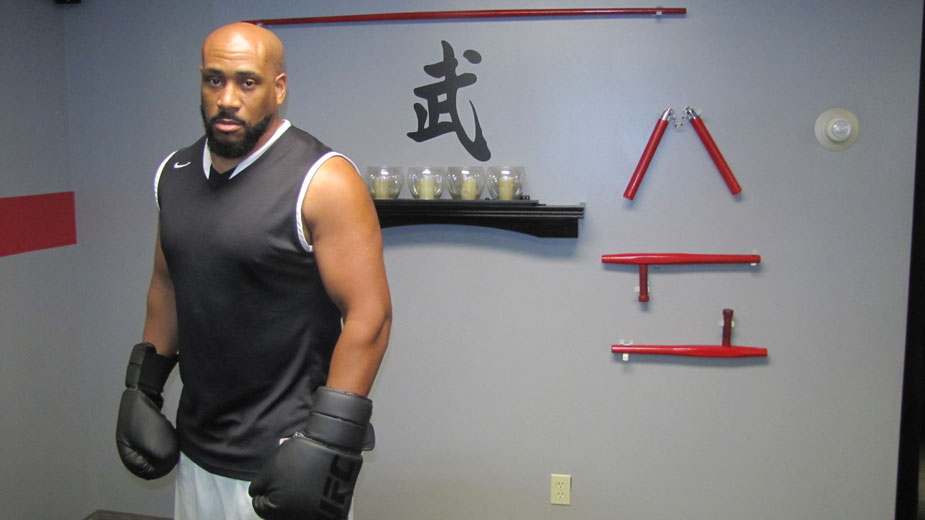Instructors Make It Clear: Self-Defense Is Serious Business
YOUNGSTOWN, Ohio – More than half of gun owners say personal protection is their main reason for owning a firearm – 67% as reported last year by the Pew Research Center. But how often are firearms actually used for self-defense?
Not very often, reports the U.S. Bureau of Justice Statistics. From 2007 to 2011, about 1% of all nonfatal violent attacks reported using a firearm to fend off an offender. In instances when the victim was armed with a gun, 32% of the time the attacker also had a firearm, compared to 63% of the victimizations where the offender had a lesser weapon, such as a knife, or was unarmed.
However, an attack that doesn’t involve a firearm isn’t any less violent, and it’s the violence that a victim is the least prepared for, says Larry Trombitas.
Trombitas instructs self-defense classes at the Davis Family YMCA in Boardman. He’s a first-degree black belt in Japanese-style karate and trained for three years in Israel in Krav Maga, a self-defense fighting style designed for Israeli military forces.
But even with martial arts training, without an understanding of violence, those who are not prepared for violence will not be prepared for a direct assault, he says.
Being violent isn’t necessarily in a person’s nature, which causes him to hesitate when attacked. If a person isn’t able to respond to an attacker with the same level – or greater – of violence that’s being initiated, “You’re going to become the victim,” Trombitas says.
“Most of us were brought up in schools and households where we were taught to be nice to people,” he says. “You don’t rip their groin out, or you don’t break their ear drum, or you don’t try to poke their eyeball out.”
But in a situation where someone is threatening your life, those are the things that must be done, he says. Instilling in a student the will to act is difficult, but it’s the basis for the classes that Trombitas teaches.
In September, Trombitas taught a free self-defense class at Sweeney Chevrolet Buick GMC in Boardman. The class was offered to customers of the dealership in response to reported attacks this summer at Mill Creek Park and Poland Township Park, says Alexa Sweeney Blackann, vice president of the dealership. The idea came from one of Sweeney’s employees, Debbie DePaul, who knows a woman who was attacked in Mill Creek Park.
“She [DePaul] noticed there weren’t any free resources for women to learn self-defense and asked if we could put something together for the community,” Sweeney Blackann says. “We were delighted that our friends at the YMCA were willing to help us offer the class to the community.”
The event drew 34 attendees and Sweeney Blackann is planning another series of classes, this time for dealership employees, she says.
“The attacks that occurred this summer in Poland Township Park and Mill Creek Park shook our communities,” she says. “We heard that not only from our employees but the customers we serve as well. We felt if we could do something to be proactive, we should.”
Trombitas says his classes initially “put the software in the brain” to prepare people to defend themselves should the need arise. Topics include surveying possible escape routes, identifying makeshift weapons and evaluating the person or people making the attack.
Classes train students to maintain control of their emotions during an attack. In the midst of a rush of adrenaline or fear, someone who isn’t trained has difficulty focusing his efforts and may “swing wildly” while trying to defend himself, Trombitas explains. Understanding violence enables a person to confront it, stay focused and meet it with an equal or greater level of violence that is needed for survival.
“All of this goes into you making a competent decision as quickly as possible, whether it’s fight or flight,” he says. “The biggest part of it is to create in the mind an understanding that you have to focus on, as terrifying as it might be, the aspects of violence coming at you.”
Similar to firearms training, students learn to differentiate between violent and life-endangering situations, he says. Students learn the proper response in a given situation, including escape, de-escalation, assertive communication, compliance or fighting back.
When responding with force is required, Trombitas teaches students to stay within the guidelines of the law. However, it’s important that they not hesitate for fear of prosecution, he says.
“In violent situations like that, it comes down to me or you,” he says. “And sometimes when you hesitate, that hesitation is going to have you end up in the hospital or in the morgue. I’d rather be in court than the morgue.”
Self-defense classes are not like some martial arts classes that focus more on form and technique, says Robert Young, who owns Efficacy Training Systems in Boardman.
In addition to teaching the “emotional content behind the aggression,” Young – who is trained in shorin ryu, aikido, jujitsu, western boxing and Chinese martial arts – engages his students in realistic situations, up to and including full contact.
Normal reactions to violence include flinching, turning one’s head away from an attack or shielding and “just taking it,” he says.
Young’s classes are designed to acclimate students to the realities of violence and to teach them how to block and successfully counter an aggressive attack “until that becomes the normal for them.” Many of Young’s students include police officers, single mothers who were victims of abuse and attacks, and others “who are serious about taking care of their loved ones,” he says.
“You come to me because you really want to take care of yourself if you’re ever put in that situation,” Young says. “You have to critique every little movement that they make until the movement is perfect enough for them to safely negotiate the strike to set up for the counter.”
Young has instructed company employees as well, including real estate agents, nurses, mail carriers, women who work alone and staff at assisted living centers and mental health clinics, he says.
Not all of those occupations may need to fight someone off; rather students learn tactics to keep from getting hurt, he says.
Young, who also has a law background, teaches customers how to block and restrain someone without doing serious damage and keeping it within the confines of what they’re allowed to do with their job.
Self-defense training is ideal for anyone who engages the public and their safety is in question, he says. His first corporate client was a pizzeria, where he helped employees understand body positioning if they are attacked, where they need to be to signal the alarm and how to escape. He also taught self-defense tactics and exercises to help enhance their overall safety, he says.
“You’re looking for any blind spots. You’re looking at the setup of their operations,” he says. “I suggest getting mirrors so they can see the blind spots and getting a bell for the door for anybody coming in and out.”
When it comes to hand-to-hand defense, Young doesn’t water it down, he says. Targets on an attacker’s body are few, but “are very effective in shutting the body down,” he says. Rather than punching someone in the mouth, he trains students to aim for joints and nerve areas, like the medulla oblongata.
Other good targets include the temple, eyes, ear, nerves in the side of the neck, and the throat, says Trombitas. He trains students to identify and use makeshift weapons – including smartphones – to inflict greater damage. Holding a smartphone tightly, he demonstrates using the corner of the device to thrust into a target area.
Both he and Young say the end goal of self-defense is to eliminate the threat and escape. And while they say an introductory class is good to start, it’s important for men and women to continue taking classes to keep the muscle memory fresh.
“Keep coming back and refreshing and reinforcing it so it becomes a reflex and not something that you have to think about,” Young advises.
Pictured: At Efficacy Training Systems in Boardman, owner Robert Young works his students up to full-contact training sessions.
Copyright 2024 The Business Journal, Youngstown, Ohio.



